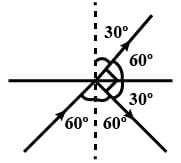Polarisation of Light - NEET MCQ
10 Questions MCQ Test Physics Class 12 - Polarisation of Light
An unpolarised beam of intensity Io is incident on a polarizer and analyser placed in contact. The angle between the transmission axes of the polarizer and the analyser is θ. What is the intensity of light emerging out of the analyser?
The Brewster’s angle for a transparent medium is 600.The angle of incidence is
The device or arrangement to detect and check plane polarized light is called
If the light is completely polarized by reflection, then angle between the reflected and refracted light is
The intensity of light transmitted by the analyzer is maximum when
A ray of light is incident on the surface of glass plate at an angle of incidence equal to Brewster’s angle Ø. If μ represents the refractive index of glass with respect to air, then the angle between the reflected and refracted rays is:
A polaroid is placed at 45° to an incoming light of intensity I0. Now the intensity of light passing through the poloroid after polarisation would be:
A ray of light strikes a glass plate at an angle of 60°. If the reflected and refracted rays are perpendicular to each other, then refractive index of glass is
An unpolarised beam of intensity 2a2 passes through a thin polaroid. Assuming zero absorption in the polaroid, the intensity of emergent plane polarised light will be
A rotating calcite crystal is placed over an ink dot. On seeing through the crystal one finds:
|
97 videos|336 docs|104 tests
|




















